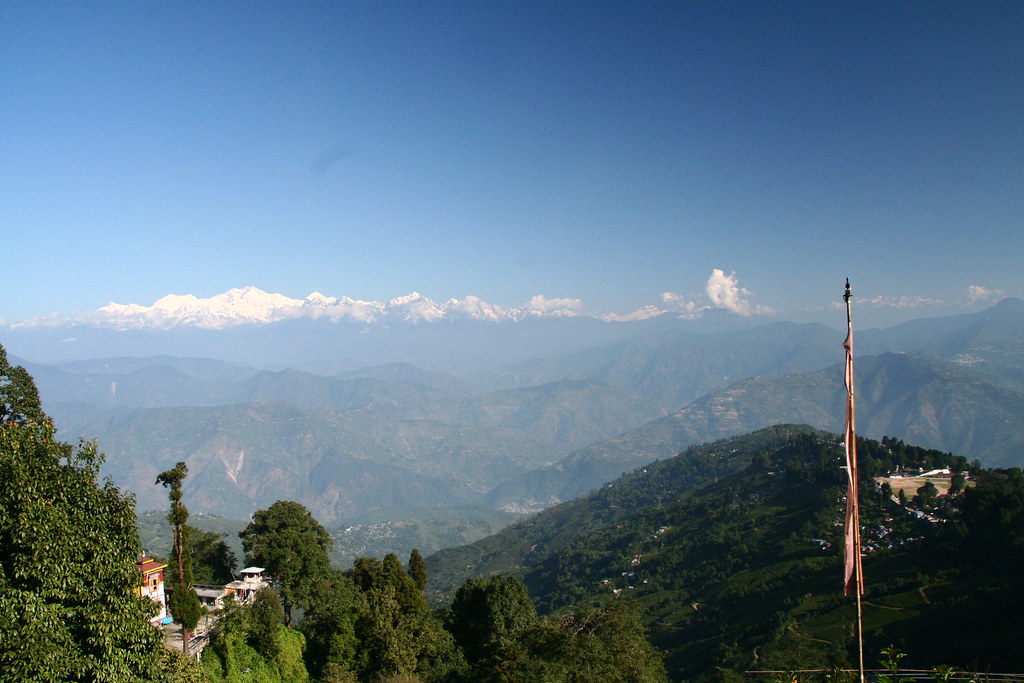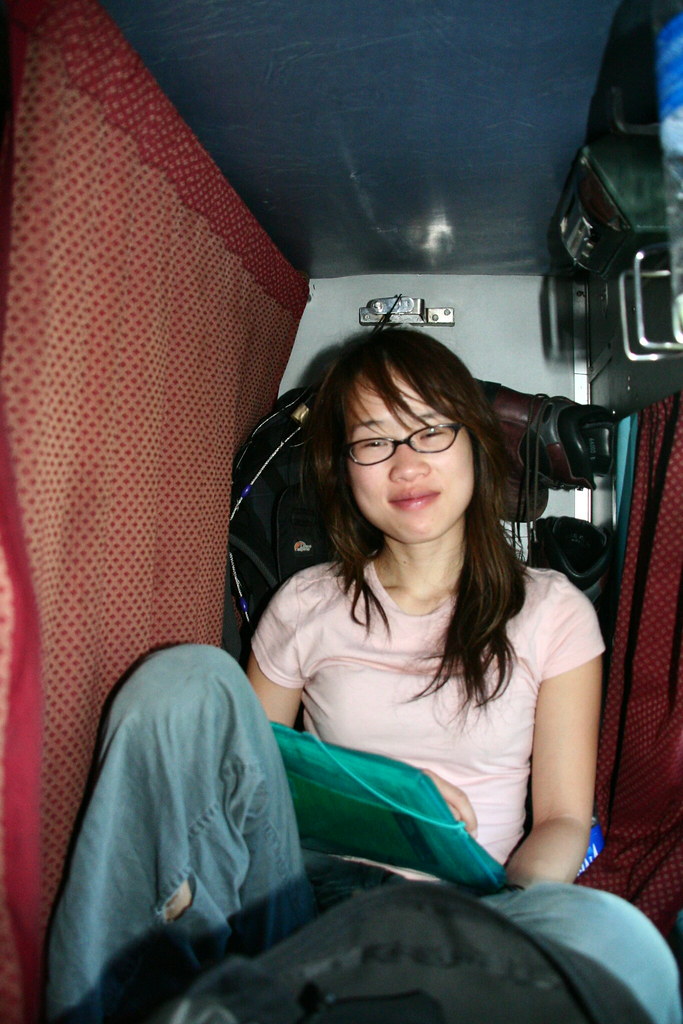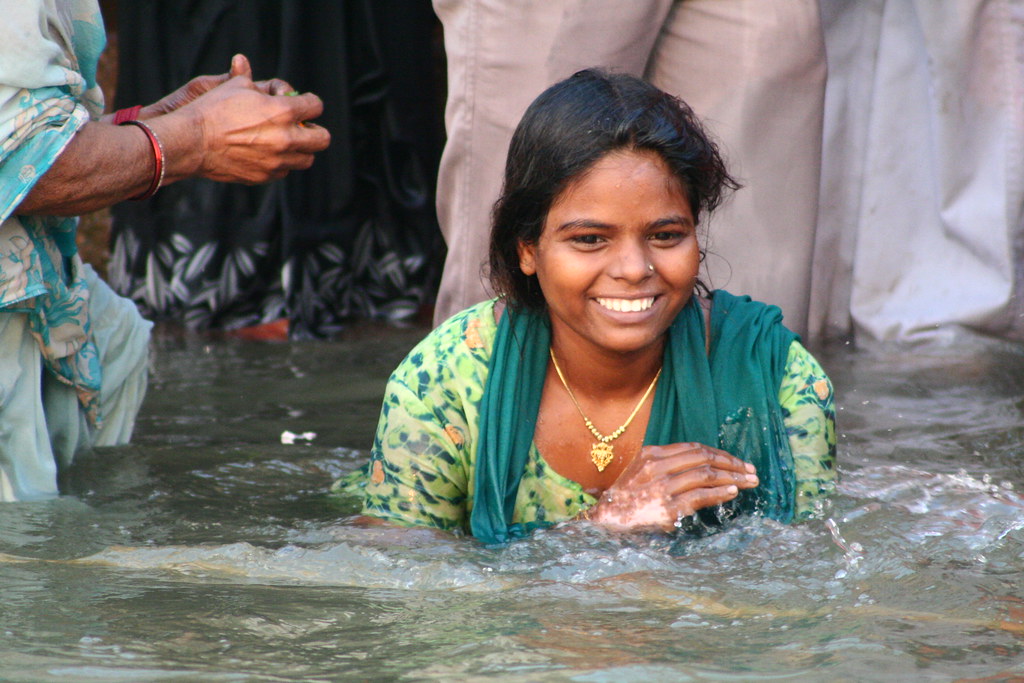Varanasi defies superlatives. Which is a good thing, since I may have used up all my superlatives in my account of travel through Tibet.
But, I get ahead of myself.
Kathmandu to Darjeeling
We arrived in Kathmandu at the start of Deepawali (or Deepavali, or Diwali), the festival of lights. That very fact made us regret treating Nepal as only a stopping-through point on our way to India. The entire city was out, awash in color, candles, light, and hospitality.
It was the latter that most impressed us. We had planned to drive across Nepal to its eastern border and cross, by land, into India. We were loath to break our no-flight rule, since we'd already had to do it once to return from Central Asia. Unfortunately, the Maoists were against us. They were, so we were told, particularly active in the east of the country, the part through which we would have had to drive. Add to that the usurious price-increase demanded by the three-day holiday, and over-land travel became prohibitively expensive and, possibly, dangerous.
So, we broke our rule, and booked a flight. The hand-written ticket which we were given was accompanied by the travel agent's wife's home-baked traditional sweet breads (not to be confused with sweetbreads, thankfully), a not-to-be-refused tilaka, a reservation at his favorite Nepali restaurant, and a pre-order of his favorite meal—he actually showed up not an hour later to join the regulars there in cards. (That the regulars included more than a few creatures bedecked in exoskeletons didn't detract from the fact that the food was a mazing).
mazing).
And what a flight that was! It was your typical, developing-world, risk-your-life sort of flight (a twenty-nine seat, properller-driven plane skirting the Himalayas, owned and operated by such a reputable organization as Yeti Airlines), and it lasted forty-five minutes and at a mere 15,000 feet. Lower, incidentally, than we were on land, not three days before. But such stunning views!
We landed, made our final over-land border crossing this trip, on foot into India, and were immediately met by the touts that make this country famous. Crooked rickshaw drivers who promised to take us one place, dropped us off twenty minutes later (for what was supposed to be a three-hour trip), and demanded a full pecuniary consideration. Cousins of friends of sisters-in-law who owned certain shops that we were sure to want to visit. Brothers who could give us special deals. Taxi Romeos, with their Brylcreem'd hair, faces like dissipated potatoes, to-the-xyphoid shirts flashing chains of gold, and porn-star mustaches the thickness of which makes you wonder how they maintain their weight, ever ready to whisk us away to dream-like destinations the likes of which exist only in their minds. And in the Lonely Planet.
But, we ascended to the nearly 7000 foot elevation of Darjeeling, crammed in the back of a jeep designed for five, jostled by an unequivocal lack of asphalt.
Darjeeling
This was India for beginners, and a great way for us to be eased into the subcontinent. Honestly, we did a whole lot of very little. We drank tea (how can you be in Darjeeling and not drink tea?). We visited a tea plantation (closed for Deepavali). We met snow leopards (in a zoo). And we drank more tea. Darjeeling was pleasant.
you be in Darjeeling and not drink tea?). We visited a tea plantation (closed for Deepavali). We met snow leopards (in a zoo). And we drank more tea. Darjeeling was pleasant.
Until we found out that there was Marxist rebel activity at the foot of that hill, too. This was the rebel activity of the blow-up-a-doctor's-car sort, and it threatened to keep us stranded up in the mountains, away from our scheduled train (which may, in the end, not have been a bad thing).
Thankfully, the strike providentially lifted long enough for us to cram ourselves, with twelve others, into another jeep made for five (the driver had to reach between some unfortunate soul's legs to change his gears) and make the treacherous descent down to Siliguri, and into the waiting arms of the train station.
And to begin what may—nephrolithiasis aside—have been the worst thirty-six hours of the trip. To date.
Train stations in India are seething pools of humanity, sleeping under stairs, balancing on their heads cardboard boxes the size of which would have caused Ayn Rand to shudder, drinking from places they shouldn't have been. But—in an attempt at a different sort of humanity—the stations are equipped with "retiring rooms," should you have the misfortune of booking a train at such a God-fearing time as 4:05 am. This attempt at humanity, though, is little more than an attempt. See, the retiring rooms are also home to myriad, multi-legged denizens of the dark. We spent our night, huddled in chairs (it's not a good sign when the sheets have droplets of blood on them), fending off fleas, roaches, bed-bugs, geckos, mosquitoes, flies, and the klaxon of passing trains. Being awoken for the fourteenth time by the patter of many-jointed insect legs on your scalp makes you ill-disposed to board an Indian train for what is supposed to be a nineteen-hour journey.
ill-disposed to board an Indian train for what is supposed to be a nineteen-hour journey.
But, board the train we did. When we booked these tickets, we decided to splurge and go for the highest class we could (this splurge cost us on the order of $2 each). Little did we know that the highest class on these trains equals the lowest on other trains.
To say that we were crammed is to understate the case. There are six beds to a berth, four together in a sane, horizontal configuration, and two squeezed against the wall of the aisle. It was into these two that we were assigned. They are less than a person wide, less than a person long, and are meant to fit both you and your luggage, which you are instructed—in no uncertain terms—to padlock to yourself. You are shielded from the outside world by a curtain on one side—through which multiple hands enter, all night, in search of alms or a loose camera—and what passes for a window on the other, darkened on both faces by decades of neglect.
It didn't help that the train's progress consisted of fifteen minutes at a crawl, followed inexplicably by a rest for thirty. The entire way. It covered the 457-mile journey at a speed of eighteen miles an hour, landing us in Varanasi after midnight.
Varanasi
Ah, Varanasi. How can you describe this city? It is an assault on senses you didn't even know you had.
Sudden colors. Pure, deafening pinks and yellows, ochres, oranges, and blues. The sounds of cows, goats, ghats, people, burning corpses, whistles, motorcycles, horns, and generators. But people sit idly by on their push-carts of bananas, barefoot, oblivious. The unctuous smell of the feces of any animal imaginable, juxtaposed with the pungent, olive-green smell of lit juniper incense. The crush of people, their hands on you, around you, their hallo-meester-rickshaw?s and hallo-sir-opium?s and konichiwas, holas, or hallomoney!s in your ears, their amputated limbs asking for alms, and their eyes imploring you to take a picture of them (at a decent price, natch). The grit on your tongue that is nothing more than the admixture of dust, grey exhaust fumes, and cremations. Your sense of safety finds itself victim the first day you get here and you realize that hotels lock their doors at night, for good reason. This is not to mention your sense of propriety, which is stripped when you turn the corner of an alley onto an older woman, her gorgeous sari hiked over her sagging hips, bent on her haunches, washing herself from a spigot placed in that particular alley corner for that particular purpose, having done her business and unaware of the smell, the sight she creates. The heat oppresses. The sun is beastly, its rays trapped in the pollution, intensifying everything. Not a single sense survives the attack that is India's holiest city.
their push-carts of bananas, barefoot, oblivious. The unctuous smell of the feces of any animal imaginable, juxtaposed with the pungent, olive-green smell of lit juniper incense. The crush of people, their hands on you, around you, their hallo-meester-rickshaw?s and hallo-sir-opium?s and konichiwas, holas, or hallomoney!s in your ears, their amputated limbs asking for alms, and their eyes imploring you to take a picture of them (at a decent price, natch). The grit on your tongue that is nothing more than the admixture of dust, grey exhaust fumes, and cremations. Your sense of safety finds itself victim the first day you get here and you realize that hotels lock their doors at night, for good reason. This is not to mention your sense of propriety, which is stripped when you turn the corner of an alley onto an older woman, her gorgeous sari hiked over her sagging hips, bent on her haunches, washing herself from a spigot placed in that particular alley corner for that particular purpose, having done her business and unaware of the smell, the sight she creates. The heat oppresses. The sun is beastly, its rays trapped in the pollution, intensifying everything. Not a single sense survives the attack that is India's holiest city.
And no wonder. It's said that dying in this city affords liberation from the cycle of death and rebirth. Through the city runs the Ganga, that holy, and wholly-polluted, river in which everything—from bodily functions to the washing of cows to laundry to the quenching of thirst to the final disposition of the deceased—happens. Add to this the sanctity of your bovine companions, and you begin to understand the stuff makes this city what it is.
Into it we went. After three months of lugging around down jackets, fleeces, gloves, and hats, all in preparation for three hours at Everest, we finally decided we would ship the stuff home. We hired a rickshaw to take us to the post-office (hey...it's a confusing city...). But, for reasons inexplicable to us, there was significant police presence on the streets, and they stopped our rickshaw driver somewhere short of some random post office. We paid him and, not realizing he had been aiming for a place that we hadn't intended to go (we'd scouted out the post office the day before), set out on foot.
On finding the post office, we were commensurately greeted by another mustachioed tout who shuttled us—of all places!—to a tailor. This man summarily sewed our belongings into a cotton pillowcase, with a Keith needle, too-thin thread, and a running-locking stitch. Twenty minutes later and Rs 50 lighter, we discovered that our friendly tout had disappeared, having surreptitiously collected his commission.
We wended our way back to the post office and were invited behind the wood-and-glass dividers separating the efficient staff from the rest of us plebeians (imagine that!). Our be-bindi'd helpmeet handed us a Magic Marker (really!) with which to address said pillow case and a mimeographed (really!) customs declaration form. This latter was peppered with such inscrutable confounders as "Choose the [X] of the package," followed by two blank lines. (It turns out the correct response to this particular double jeopardy is to fill the two lines with "Only gift items.") We paid him more than the average GDP of a small country for ten pounds of winter wear, sent "registered." All this means, though, is that we get a nine-digit number with which we can complain if things go wrong.
"But don't worry sir. Everything OK." We'll find out in a matter of months.
And so, we retired to our fly-surrounded, but eminently peaceful hotel. We tho ught. It turns out that the twelve hours between sunset and sunrise that night were a major holiday in Varanasi, a particularly hallowed time for citizens of the neighboring state of Bihar to wash in the Ganges. And, starting at 4pm, the pilgrims arrived. The holy river filled itself with nearly-naked bodies brushing their teeth, washing, lathering, praying, laughing, splashing, floating candles, throwing garlands, eating, chewing paan, and, in general, being holy amidst the countless peeing cows, braying goats, clicking geckos, and squawking monkeys who joined the celebration.
ught. It turns out that the twelve hours between sunset and sunrise that night were a major holiday in Varanasi, a particularly hallowed time for citizens of the neighboring state of Bihar to wash in the Ganges. And, starting at 4pm, the pilgrims arrived. The holy river filled itself with nearly-naked bodies brushing their teeth, washing, lathering, praying, laughing, splashing, floating candles, throwing garlands, eating, chewing paan, and, in general, being holy amidst the countless peeing cows, braying goats, clicking geckos, and squawking monkeys who joined the celebration.
We snatched our cameras, found ourselves a boat made of little more than six garishly-painted planks of wood and commanded by a centuries-old Charon in a blue turban, and plunged ourselves in the wash of life and death that is this amazing city.
17 November 2007
Aghast
Posted by
M
at
11/17/2007 07:49:00 AM
![]()
Labels: India
Subscribe to:
Post Comments (Atom)





1 comment:
Hi Peggy (and Mark)!
Your account of this trip is wonderful. I hope the both of you are doing well and enjoying yourselves - I would love to see the pictures!
Reena
Post a Comment